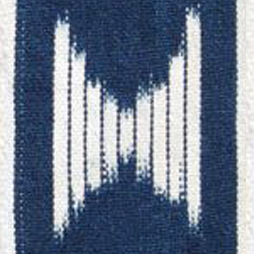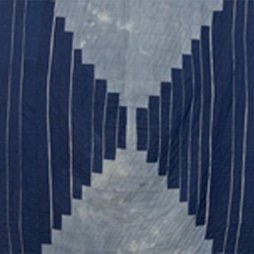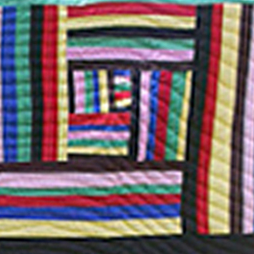Gee's Bend Quilts
African Origins of an African American Textile
The Gee's Bend quilt story starts in Africa, where a musical style of “polyrhythms” was invented. For example, think about Solomon Linda's famous song “The Lion Sleeps Tonight”. The base sings continuous whole notes, visualized here as horizontal lines. The lyrics are quarter notes on top, 4 vertical lines. In the last bar it flips: the word “night” is drawn out as one continuous whole note, and the base singer gives four separate notes.
Now imagine compressing those alternating parts into one solid row, and adding a row for each line in the song. You might get something like the alternating patterns we see in this kente cloth. Another alternating pattern is “call and response”, where the singer has the audience interact. Scholars suggest this represents alternating between leaders and followers, which is part of the African tradition of social equality.
The African musical traditions: call and response, syncopation, polyrhythms -- are similar to African visual traditions we can see in their textiles. Both are in a sense using related “heritage algorithms”. That is why African American gospel, soul, funk and hip-hop all sound related. When black preachers say “can I get an Amen” they are doing call and response, alternating leader and follower, melody and base.

This cloth was created by African Americans in the Gee's Bend community of Alabama. What is the similarity to kente cloth? If you guessed alternation, you are right. However the alternating vertical and horizontal stripes seem more free-form or unpredictable than in kente. Similar changes happened in music: jazz has clear roots in African traditions, but it too is more free-form.
Now let's look at scaling. The clip (on the right) from Ray Charles is not only call and response, but the response times get smaller with each iteration:
In African textiles, you can see visual patterns that get smaller with each iteration. On the bottom left side we see indigo cloth from Nigeria. On the bottom right side we see a Gee's Bend quilt. In both cases there are similar patterns at many scales.


While alternation switched angles in every iteration, scaling changes the size in each iteration. As another example of scaling, compare the many scales of colorful stripes in this kente cloth at left to this Gee's Bend pattern.


How did these African algorithms end up in America? Starting in 1812, groups of enslaved Africans were brought to Gee's Bend, Alabama. Isolated on three sides by a bend in the river, the community had less external influence, so cultural traditions could continue to evolve on their own. Even as late as the 1930s the area was sometimes referred to as “African Alabama”.
In 1965, Dr. Martin Luther King, Jr. visited Gee's Bend from nearby Selma to preach at their church. From this, he gained followers who then marched with him from Selma to Montgomery. Unfortunately, white business owners fired any worker who had marched or registered to vote. These workers started the Freedom Quilting Bee in 1966 as a new source of income. The work was later contracted by Sears, and soon the quilts' extraordinary aesthetics gained a place in prominent art museums like the Smithsonian. The simulations you create can help keep these spectacular heritage algorithms alive and evolving in new ways.